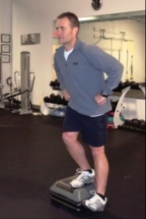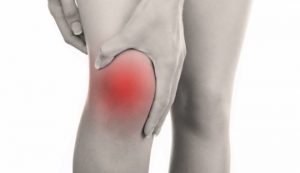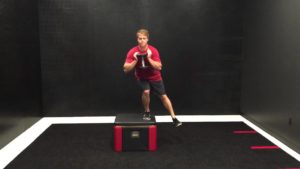The Lateral Step Down is one of the Best Strengthening Exercises for Knee Pain
The prevalence of knee pain is extremely common in the United States, affecting nearly 25% of people at any given  time (1). Knee pain limit a person’s ability to work and earn income for their family. There are many different causes of knee pain including osteoarthritis, meniscus tears, ligament injuries, etc. and there is no one exercise that is the best for all of those causes of pain. However, one of my favorite and most commonly prescribed exercises within the clinic to improve strength is the eccentric lateral step down. All you need is a step and few minutes each day and you can be on your way to pain free movement. can be debilitating, can limit one’s ability to walk, perform stairs navigation, stand for extended periods, and even get a good night’s sleep. It can
time (1). Knee pain limit a person’s ability to work and earn income for their family. There are many different causes of knee pain including osteoarthritis, meniscus tears, ligament injuries, etc. and there is no one exercise that is the best for all of those causes of pain. However, one of my favorite and most commonly prescribed exercises within the clinic to improve strength is the eccentric lateral step down. All you need is a step and few minutes each day and you can be on your way to pain free movement. can be debilitating, can limit one’s ability to walk, perform stairs navigation, stand for extended periods, and even get a good night’s sleep. It can
Why Is Strengthening Important for Knee Pain?
Strength is extremely important for our bodies and the active of strengthening is protective for our joints. The improvement in strength and simply the act of performing strengthening exercises has been shown to decrease pain, improve overall function, and reduce the long term risk for injury. Hip and knee strengthening has been shown to reduce the incidence of ACL tears in young athletes, improvement in anterior knee pain, and improvement in quality of life in patients who suffer from osteoarthritis.
Strength is also important component in recovering after an injury. After an injury, strengthening is critical to return to prior levels of strength. Without normal strength you may not be able to return to normal activities and normal movement. Returning to pre-injury strength levels helps avoid re-injury, decreases the risk for injuries to become chronic and avoid compensation in other areas of the body. It also helps improve healing times by promoting blood flow, improvement in the function of the nervous system, aids in swelling management, and helps reduce pain levels.
After surgery, muscle strength is one of the primary indicators that the body is healed or healing. The medical professional team may use this exact same exercise to assess the strength of the hips and leg. It’s always best to check with your surgeon or physical therapist before attempting this exercise to make sure it is not contraindicated at the current stage of healing.
What is the Eccentric Lateral Step Down?
Despite the long name, the eccentric lateral step down is a relatively simple exercise in appearance only.  As those who have experience performing it already know, it is much harder than it looks. To perform the exercise, start by standing on the side of the step facing sideways. Start with both feet on top of a step. Next, slowly lower the unaffected leg down off the side of the step and lightly touch the heel to the floor. Without putting any extra weight in the unaffected leg return to the original position with both feet on the step. It is important to maintain proper form to work the desired muscles. Here are some key points:
As those who have experience performing it already know, it is much harder than it looks. To perform the exercise, start by standing on the side of the step facing sideways. Start with both feet on top of a step. Next, slowly lower the unaffected leg down off the side of the step and lightly touch the heel to the floor. Without putting any extra weight in the unaffected leg return to the original position with both feet on the step. It is important to maintain proper form to work the desired muscles. Here are some key points:
- Knee in line with the 2nd toe and not passing in front of the toes.
- Don’t let the other side of the pelvis drop or essentially performing a hip dip
- Do not let the knee move inward towards the other leg, this is called knee valgus
- Do not let the foot collapse inwards towards the other leg, try to maintain a normal arch in the foot
- Finally, don’t allow vaulting or pushing yourself back up with the unaffected foot to return to the starting position.
 Do you have pain in the front of the knee that won’t go away? See our post on The Best Patella Tracking Braces
Do you have pain in the front of the knee that won’t go away? See our post on The Best Patella Tracking Braces
Why We Love This Exercise
This is a frequently prescribed exercise for many reasons, some of the reasons are listed below.
Easy to do by Yourself!
- You do not need any fancy equipment to perform. It can be done on the single step going from the garage into the house. You don’t have to have anyone there to help you and gives you a tool to help with pain at home.
Increasing Hip Strength
- This exercise strengthens the entire lower extremity but particularly the hip. The knee is often said to be a joint that’s dependent on the hip and the ankle, and this exercises targets both. You hip has to control and work in multiple directions, it has to keep your pelvis level, help lower your body, and help control your knee from going inwards.
- In addition, when hip and knee strengthening are combined studies have shown this to be more effective for some types of knee injuries such as Patellofemoral Pain Syndrome, then knee strengthening alone
Ankle Motion Control
- To complete the lateral step down you must maintain ankle motion. To make it even more challenging, try performing without shoes so that there is no external support for the foot
Quad Control and Strength
- This is one of the best bang for your buck exercises for quad strength. When you look at the lateral step down, it is essentially a modified single leg squat. However, performing eccentrically, or the slow lowering causes the muscles to tension while also being lengthened simultaneously. This causes the maximum amount of force within a muscle.
Control of Multiple Planes
- To perform the lateral step down correctly, you have have to control your body in multiple planes of movement. There is the control of vertical motion, up and down. There is also control of the pelvic drops laterally and finally controlling the rotational forces on the leg when the knee wants to rotate inward.
Balance Training
- Because this exercise is performed in single leg stance there is a substantial balance requirement. This becomes especially difficult after multiple repetitions as this requires an extended period of balancing on one leg i.e. around 30 seconds or more.
Eccentric Loading
- We’ve discussed this a little previously, but eccentric loading puts the greatest amount of stress on the muscle performing the movement in the shortest amount of time. To improve muscle strength, the body has two mechanisms; improve the communication between the nerve and the muscle, or the body can hypertrophy the muscle and increase its size. The eccentric load required in this exercise will help improve strength via both mechanisms for better all around strength improvement.
Cheap, Easy to perform, and Easy to Progress
- To perform this exercise the only requirement needed is a step or elevated surface.
 If you don’t have a step at your home residence then the post office, work place, or even the local park will likely have one step. That’s all you need, it’s so easy! Finally, if it is no longer a challenge after weeks of performing that increasing the difficulty is simple. You can:
If you don’t have a step at your home residence then the post office, work place, or even the local park will likely have one step. That’s all you need, it’s so easy! Finally, if it is no longer a challenge after weeks of performing that increasing the difficulty is simple. You can:
-
- Increase the height of the step
- Hold a weight or kettlebell for more resistance
- Close your eyes to increase the balance requirements
- Put an unstable surface such as a pillow or dynadisc underneath your foot
- Increase the repetitions
-
Knee Strengthening Program Recommendations
Now you know what the exercise is, you know how to perform it correctly, and you also know why we have such an infatuation with the exercise. The only pertinent information left to discuss is the best program to follow to get results.
- Repetitions: try to complete 3 sets of 10-15 reps. The last repetitions should be difficult to perform in the third set. If not increase the resistance with one of the strategies listed above.
- Frequency: Try to perform 4-5 days a week. It’s important to allow for a few days rest but it’s also important to maintain a consistent program to induce tissue changes.
- Duration: You need to perform for at least 6 weeks. I know, I know, in today’s world of instant gratification 6 weeks seems like an absolute lifetime! However this is the time required to make both muscle hypertrophy and nerve communication improvements. 6 weeks of strengthening has be shown to reduce pain levels to near normal levels in those suffering from anterior knee pain.
I Don’t Have Any Equipment at Home to Perform, What Do I Need?
Who Should Not Perform Knee Strengthening Exercises
As always there are risks with performing an exercise program. The patients that tend to have the less success with this exercise those with severe retro patella arthritis, severe Tibiofemoral arthritis, and those with severe obesity may have increased pain. There is expected to be to be delayed muscle soreness after starting any strengthening exercises. This exercise may produce too much stress for those that suffer from injuries listed above and should start with exercises requiring less torque on the knee joint.
Finally, anyone who has a heart condition that does not allow them to exercise safely. As always this list is not fully inclusive and you should consult a medical provider with any questions before starting an exercise program.
Works Cited
- Jinks C, Jordan K, Croft P. Measuring the population impact of knee pain and disability with the Western Ontario and McMaster Universities Osteoarthritis Index (WOMAC) Pain. 2002;100:55–64.
Disclaimer: The information provided in this post is for educational purposes only. This is not a substitute for a medical appointment. Please refer to your physician before starting any exercise program.




